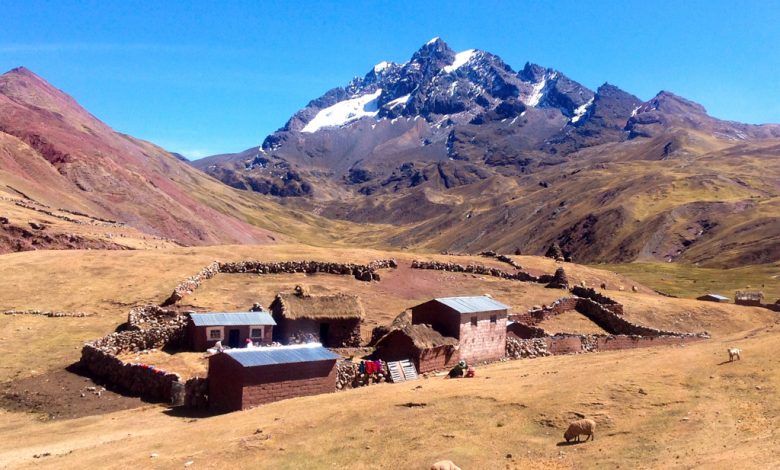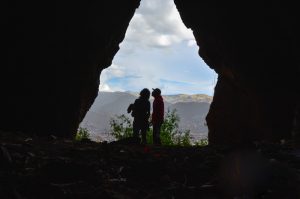The Mountains, Rivers, and Lakes Claim Devotion in Cuzco and Beyond

Mountains surround Cuzco, as is fitting for a very mountainous Peru where the mountains stand up from the coast like a wall that divides the country. Only the Amazonian plains are without mountains, though even there one feels the presence of the wall from which cold water races down. It is fitting, as a result, that Andeans have been argued to worship the mountain peaks and land forms.
The great mountains are called Lords, or Apus, and many other elements of the land are known as huacas, or wacas. Caves also abound and many of them, along with springs and lakes, are known as origin points from which people came out into the world, though not all. The great mountain Lords, covered with snow, anchor discussions and stories from large regions and become not just landmarks but points of cosmological reference.
Despite the evident importance of the Apus for Andeans, anthropologist Peter Gose recently looked back into ethnohistory, the study of documents from the early colonial past to understand the origin and changing importance of these mountain lords.
Gose argues that the mountains originally were homes for mummy bundles of heroic ancestors who founded the key social groups, ayllus, that organized the political, economic, and social world in which people lived. He finds ample evidence in documents from the sixteenth and seventeenth centuries that people did not worship the land, per se, but their ancestors whose bodies required feasting and this organized religion, politics, economy, and society.
However, the Spanish, in order to destroy indigenous religion and develop a Catholic political economy attacked the mummy cults of the ancestors and burned the key elements, the human remains of the ancients. The actively sought out any remaining mummy to destroy in order to break the link between post-conquest society and ancestral religions, at the same time they Spanish depended on native caciques, head men, to rule for the benefit of the Spanish crown.

According to Gose, this created a double crisis, one in which the mummies were disappearing though their memory remained as did their attachment to the land and one in which the native leaders were losing credibility and legitimacy for Indians at the roots of colonial society. The memories of mummies seeding the landscape by inhabiting caves and tombs (ch’ullpas) remained even when the mummies were gone and spawned cults dedicated to the landforms themselves. In addition, society changed so that loyalty was no longer to the ancestral communities, with their headmen, the ayllus, but to territorial based communities such as are found today, with their rituals and dedication to the mountains and other earth shrines.
Gose’s book, Invaders as Ancestors: On the Intercultural Making and Unmaking of Spanish Colonialism in the Andes (University of Toronto Press, 2008) is brilliant, carefully argued, and extraordinarily well documented. Nonetheless, it seems to miss a current that is broader than simply the Andes, the way in which land forms through out much of the Americas anchor or witness to heroic events from myth-time, the origin time, even when the specific mechanisms of Spanish colonialism from Peru were absent.

Two examples, the late Keith Basso noted the ways in which the landscape anchors and encodes memory of ancestral narratives, without the mechanism of mummies and Spanish colonialism that motivated Gose’s work so productively. In his work Wisdom Sits in Places: Landscape and Language among the Western Apache (University of New Mexico Press, 1996) Basso provides evidence something greater than simply the colonial machinery, involving both Indians and Spaniards as well as all the other people of Peru, is at work to produce the current devotion to landscape.
Additional evidence comes from a more recent book by Robin M. Wright, Mysteries of the Jaguar Shamans of the Northwest Amazon (University of Nebraska Press, 2013). Wright argues that the land of the northwest Amazon inhabited traditionally by Araway speakers, demonstrates in its use still today by the few remaining Jaguar Shamans and prophets a large integrated landscape covering an enormous portion of the jungled landscape that is a petrification (his word) of a myth cycle of origin and morality.
Wright argues that this landscape and its widespread mythology argues for a pre-contact society that was large-scaled and developed with roads between sites, priests, and hence much more formalized political hierarchy than found today.
Arawak is a language family that reached into the Andes. Some scholars, such as Rudolf Cerron Palmino argue that the Incas themselves spoke an Arawak language, Puquina, and that language may have been the speech of the great Tiwanaku empire that preceded them.
Nevertheless, Wright notes that the landscape organized a multilingual, multi ethnic population where at the root was found the Kuwai myth cycle. Both Tukanoan and Arawak speakers maintained versions of it and developed their specific political and social, as well as religious forms around versions of it in a way that connected them with the local landscape.
In passing, let us note that the presence of the Kuwai cycle reminds us of another large scale cycle, though a very fragmented one, from the Andes called simply the Thunupa cycle, reminding of the creator hero, whichever names was used for him. This cycle also organized a multilingual and multiethnic society involving Arawak speakers, as well as Quechua and Aymara, as best we can tell today.
For us though, the central importance of land forms requires that we recognize the importance of Gose’s contribution but also think with it and past it into this widespread, Amerindian, focus on land shapes and forms, not as in a worship of the whole earth, but in specific rocks, rapids, mountains, rivers, and caves that semiotically encode, witness to, or simply are the ancestral forms of life, without the immediate mediation of mummies, although ancestral remains were undoubtedly important in the Amazon as well as in the highlands.
We may need to rethink our semiotics, the relationship of signifier to signified, in order to grasp how specific landforms have organized or been used to organize polities and societies across a broad space of the Americas in, perhaps, different ways. It is the presence of this form, far beyond the specifics of the Andes, that demands more than Gose’s brilliant and significan analysis can offer.
Apu Ausangate stands at the northern end of the Huatanay Valley and gleams at Cuzco when the sky is clear. People speak of him as an Apu. There is so much more to his existence and interaction with people than any simple statement that people worship the earth might suggest. Much more work is needed.




